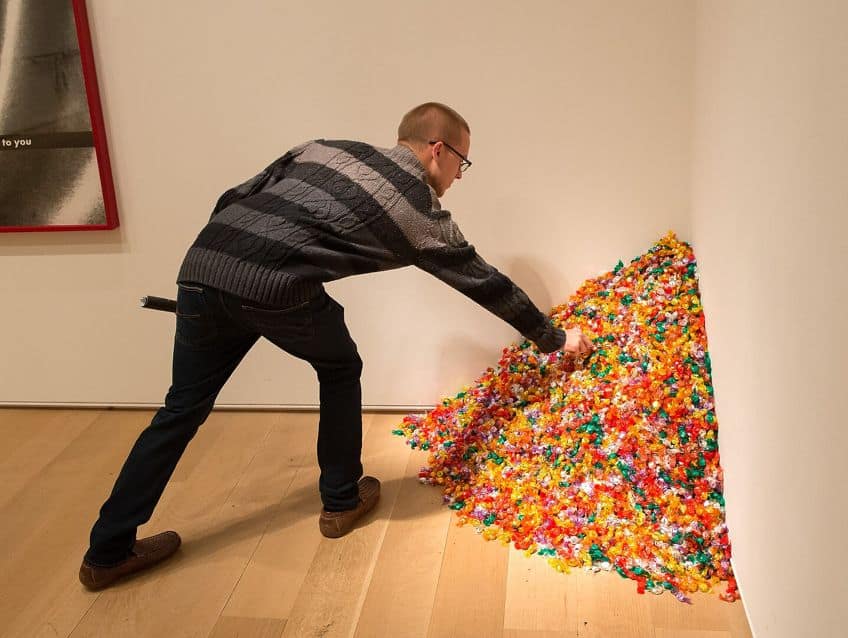“Untitled (Portrait of Ross in L.A.)” – Art by Félix González-Torres
Félix González-Torres’ Untitled (Portrait of Ross in L.A.) is a poignant exploration of love and loss amidst the AIDS crisis. Using everyday materials like candies, the artwork invites viewers to contemplate themes of memory, absence, and human connection. Through its subtle yet powerful symbolism, González-Torres creates a space for collective reflection on the ephemeral nature of life and the enduring power of intimacy. As we delve into the layers of symbolism and emotion within this iconic piece, we embark on a journey that transcends individual experience, resonating with universal truths of love and remembrance.
Key Takeaways
- Untitled (Portrait of Ross in L.A.) reflects on themes of love and loss through its interactive candy installation.
- The work’s ideal weight of 175 pounds is a direct reference to the artist’s partner, making the piece a deeply personal memorial.
- The transient nature of the installation allows the audience to engage with the concepts of impermanence and memory.
Creation and Concept
| Artist | Félix González-Torres (1957 – 1996) |
| Date Created | 1991 |
| Medium | Candies wrapped in multicolored cellophane, generally weighing 175 – 200 pounds |
| Genre | Contemporary art |
| Period/Movement | Postmodernism |
| Dimensions (cm) | Variable (Dimensions vary according to installation) |
| Series/Versions | N/A |
| Where Is It Housed? | Art Institute of Chicago, Illinois, United States |
| What It Is Worth | Conceptually priceless (can be replicated according to the artist’s instructions) |
In 1991, artist Félix González-Torres created Untitled (Portrait of Ross in L.A.), a poignant work blending personal and public narratives, signifying the intimate and broader impacts of AIDS through the medium of candies. Félix González-Torres conceptualized Untitled (Portrait of Ross in L.A.) after his partner, Ross Laycock, succumbed to an AIDS-related illness. This piece serves both as a tribute to Laycock and as a means to present the weight of love and loss.
The use of candies to represent Ross’s diminishing body weight through his illness until his passing, starkly represents the physical decline associated with the condition.

Themes
Love and death intersect in this work, providing a glimpse into the artist’s personal life while inviting communal participation. As viewers are allowed to take candies from the installation, the themes of loss and regeneration manifest, embodying both the essence of Laycock and the impermanence of life. The piece also reflects on the Meaning of the couple’s relationship as it withstands the ultimate separations of death.

Untitled (Portrait of Ross in L.A.) parallels another work by González-Torres, entitled Perfect Lovers, in which he tackles the perception of time in relation to love’s continuity despite physical absence. This integrative use of art to channel personal grief into a universal conversation marks a period when AIDS was heavily stigmatizing, amplifying the need for awareness and compassion.
Formal Analysis
In assessing the work Untitled (Portrait of Ross in L.A.) by Félix González-Torres, one must consider the non-traditional materials and mutable nature of the installation. The work stands as an interactive piece with a strong embrace of temporal elements.

Materials Used
The composition of Félix González-Torres’ Untitled (Portrait of Ross in L.A.) features candies meticulously arranged in various colored wrappers, symbolizing both the sweetness of life and the diversity of human experience. With an ideal weight of 175 lbs., mirroring that of the artist’s partner, Ross, the installation carries profound personal significance. Its nature as an endless supply of candies, meant for the audience to take pieces from, evokes themes of loss, impermanence, and the passing of time.
Through this interactive aspect, viewers are invited not only to engage with the artwork physically but also to contemplate the transient nature of existence and the enduring legacy of love and memory.
Visual Description
As an installation, Untitled (Portrait of Ross in L.A.) is adapted to the space it occupies, with dimensions that vary per installation. The candies are spread out on the floor or contained within a corner or perimeter, often appearing as a luminous carpet due to the reflective quality of the wrappers.

Symbolism
Each candy serves as a poignant symbol, encapsulating both the sweetness of Ross’s life and the chronicle of his weight loss due to illness. As viewers interact with the installation, the act of taking candy away mirrors the loss and decline in Ross’s health over time, embodying the emotional and physical toll of the AIDS epidemic. In this way, the artwork becomes a living testament to the fragility of existence and the profound impact of illness on both individuals and communities.
Through its subtle yet powerful symbolism, Untitled (Portrait of Ross in L.A.) invites contemplation of life’s transient nature and the enduring legacy of love amidst adversity.
Permanence of Work
The installation is designed for flux; as viewers interact with and reduce the pile of candy, the work’s physical presence diminishes, reflecting the transient nature of life. The replenishment of candies ensures that the work maintains its ideal weight, aligning with the concept of an endless supply and continual presence despite change.

Influence on Contemporary Art
Untitled (Portrait of Ross in L.A.) has significantly influenced contemporary art, particularly in Conceptual art, by merging personal narrative with universal themes. Through the use of everyday materials, González-Torres creates interactive installations that invite viewers to physically engage with the artwork, taking pieces of candy from the exhibit.
The choice of candy symbolizes the weight of the artist’s partner, Ross Laycock, who battled AIDS, transforming the artwork into a powerful metaphor for loss and the impact of the epidemic.
By allowing the audience to consume the artwork, González-Torres confronts societal taboos and exclusionary politics surrounding AIDS, reshaping the discourse of Contemporary Art. Untitled (Portrait of Ross in L.A.) not only commemorates those lost to the epidemic but also challenges cultural narratives, positioning art as a catalyst for social change and collective healing.
Museum Exhibitions
Untitled (Portrait of Ross in L.A.) is permanently housed in the collection of the Art Institute of Chicago, where it serves as a poignant centerpiece among the museum’s contemporary art holdings. Its presence not only enriches the institution’s collection but also offers visitors a profound opportunity to engage with themes of love, loss, and memory in a deeply personal and interactive way. As a cornerstone of the museum’s permanent display, the artwork continues to inspire dialogue and reflection, ensuring González-Torres’ profound exploration of the human experience endures for generations to come.

The Guggenheim Museum has featured González-Torres’ works, including this poignant piece, as part of its dedication to showcasing significant contemporary art. Similarly, the Whitney Museum, renowned for its comprehensive exhibitions of modern American art, has provided a platform for González-Torres’s impactful installations, contributing to the artist’s enduring legacy in the realm of contemporary art.
In essence, Félix González-Torres’ Untitled (Portrait of Ross in L.A.) serves as a profound reflection on love, loss, and memory. Through its simple yet evocative composition, the artwork invites viewers to contemplate the enduring impact of the AIDS epidemic. As we engage with its symbolism, we’re reminded of the resilience of the human spirit and the power of shared experiences. Ultimately, González-Torres’ masterpiece stands as a timeless tribute to love’s ability to transcend time and space, leaving an indelible mark on all who encounter it.
Frequently Asked Questions
What Does the Pile of Candy in the Artwork Symbolize?
The pile of candy is a representation of the artist’s partner, Ross Laycock, who was battling AIDS. Each piece of candy in the installation weighs approximately 175 pounds collectively, which was Ross’s healthy body weight. As visitors take candy from the pile, embodying the loss of weight and deterioration of the body due to the illness, the diminishing supply echoes the tragic withering of life in the face of disease.
What Role Does the Concept of Ephemerality Play in González-Torres’s Candy Work?
Ephemerality is central to González-Torres’s installation which employs an endless supply of candy that is continuously replenished. This ever-changing nature reflects on the temporary aspects of life, memory, and the ongoing cycle of presence and absence. By allowing the public to interact with the piece, González-Torres infuses the work with a sense of community and shared loss, highlighting the fragile and transient aspects of human existence.
Isabella studied at the University of Cape Town in South Africa and graduated with a Bachelor of Arts majoring in English Literature & Language and Psychology. Throughout her undergraduate years, she took Art History as an additional subject and absolutely loved it. Building on from her art history knowledge that began in high school, art has always been a particular area of fascination for her. From learning about artworks previously unknown to her, or sharpening her existing understanding of specific works, the ability to continue learning within this interesting sphere excites her greatly.
Her focal points of interest in art history encompass profiling specific artists and art movements, as it is these areas where she is able to really dig deep into the rich narrative of the art world. Additionally, she particularly enjoys exploring the different artistic styles of the 20th century, as well as the important impact that female artists have had on the development of art history.
Learn more about Isabella Meyer and the Art in Context Team.
Cite this Article
Isabella, Meyer, ““Untitled (Portrait of Ross in L.A.)” – Art by Félix González-Torres.” Art in Context. February 20, 2024. URL: https://artincontext.org/untitled-portrait-of-ross-in-l-a/
Meyer, I. (2024, 20 February). “Untitled (Portrait of Ross in L.A.)” – Art by Félix González-Torres. Art in Context. https://artincontext.org/untitled-portrait-of-ross-in-l-a/
Meyer, Isabella. ““Untitled (Portrait of Ross in L.A.)” – Art by Félix González-Torres.” Art in Context, February 20, 2024. https://artincontext.org/untitled-portrait-of-ross-in-l-a/.











